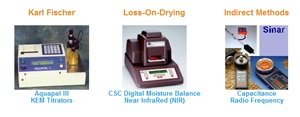I started by weighing-in with a shot at interpreting evaporation, while hinting that I'd take on the other principles that effect loss-on-drying moisture tests at some point in the future.
I've decided to have a go at vapor pressure. Why vapor pressure now --- because it's next on the list.
I guess as good a place to start as any, is with a definition:
- Vapor Pressure is the Equilibrium Pressure of a vapor above its liquid or the pressure of the vapor resulting from evaporation of a liquid above the sample.
To refresh the image , from the past musing on Moisture Mysteries, of evaporation, molecules bounce out of a liquid into a gas. When the evaporation settles down rather than flying off into the vapor, the molecules above the liquid in the vapor or gas ,continuously exchange places with the molecules at the surface of the liquid, the liquid and vapor are in equilibrium. That is when you have Equilibrium – Vapor Pressure.
molecules bounce out of a liquid into a gas. When the evaporation settles down rather than flying off into the vapor, the molecules above the liquid in the vapor or gas ,continuously exchange places with the molecules at the surface of the liquid, the liquid and vapor are in equilibrium. That is when you have Equilibrium – Vapor Pressure.
This vapor pressure is a unique characteristic of a pure liquid. The molecular bonding of the pure liquid defines its unique vapor pressure.
-
Weak bonding high vapor pressure
-
Strong bonding low vapor pressure
To see how it works you have to look at the dynamics. Dynamics have always complicated my life.
For any pure liquid, dynamics fortunately are only related to temperature. We stated that each pure liquid has a unique vapor pressure, but that value changes with temperature. Unique but changing – can that be? Yes because a unique vapor pressure is defined at a each temperature. It goes up as the temperature rises and goes down as the temperature declines.
temperature. We stated that each pure liquid has a unique vapor pressure, but that value changes with temperature. Unique but changing – can that be? Yes because a unique vapor pressure is defined at a each temperature. It goes up as the temperature rises and goes down as the temperature declines.
Fortunately for our understanding, the surface area of a liquid has zero effect on Vapor Pressure. I'm not 100% sure why I even mention this except that if this was not a constant, it would confuse the energy issues related to getting evaporation, which is why we started this whole rant.
Because we are rambling about moisture, the liquid we refer to will be water.
To generate evaporation and get the water out , which we need to do when we conduct Loss On  Drying Tests, energy needs to be added to the test sample. The energy is some form of heat which increases the Vapor Pressure, the molecules start bouncing around and move from the liquid state to gas. With loss-on-drying moisture test equipment, the gas or water vapor is moved away from the sample so that the water vapor has no chance to get back to the water surface and start an equilibrium exchange with the water.
Drying Tests, energy needs to be added to the test sample. The energy is some form of heat which increases the Vapor Pressure, the molecules start bouncing around and move from the liquid state to gas. With loss-on-drying moisture test equipment, the gas or water vapor is moved away from the sample so that the water vapor has no chance to get back to the water surface and start an equilibrium exchange with the water.
That's how Vapor Pressure relates to a loss-on-drying moisture test.
I'm not sure but, in future ramblings, I might take on water content complexities, water activity witchcraft and just plain drying. Should I?
I hope this expose/rant was somewhat interesting and useful. I welcome your comments. Thanks for reading it.
As usual a perplexed,
Art
P.S. Did you know that you can subscribe to these exposes, rants, raves and ramblings? Simply jot your email address in the box just to the right of the title.
P.P.S. Take a look at another perspective on Moisture.


